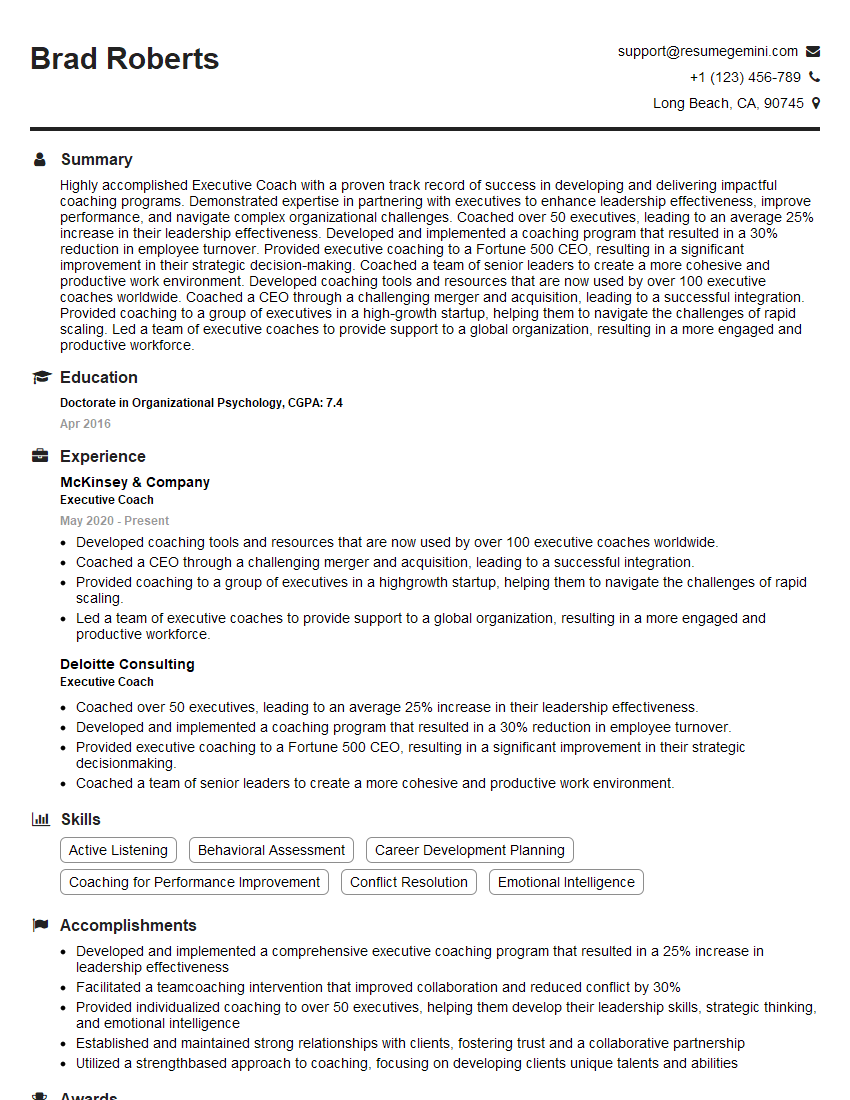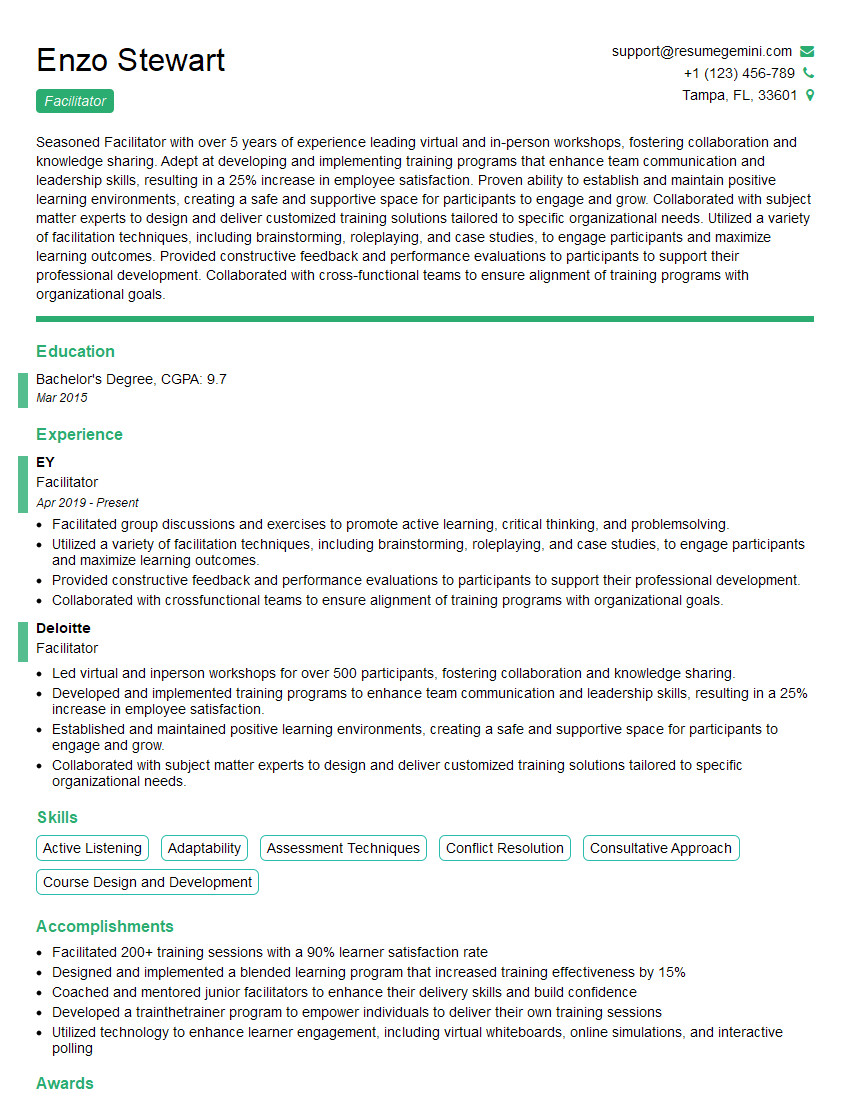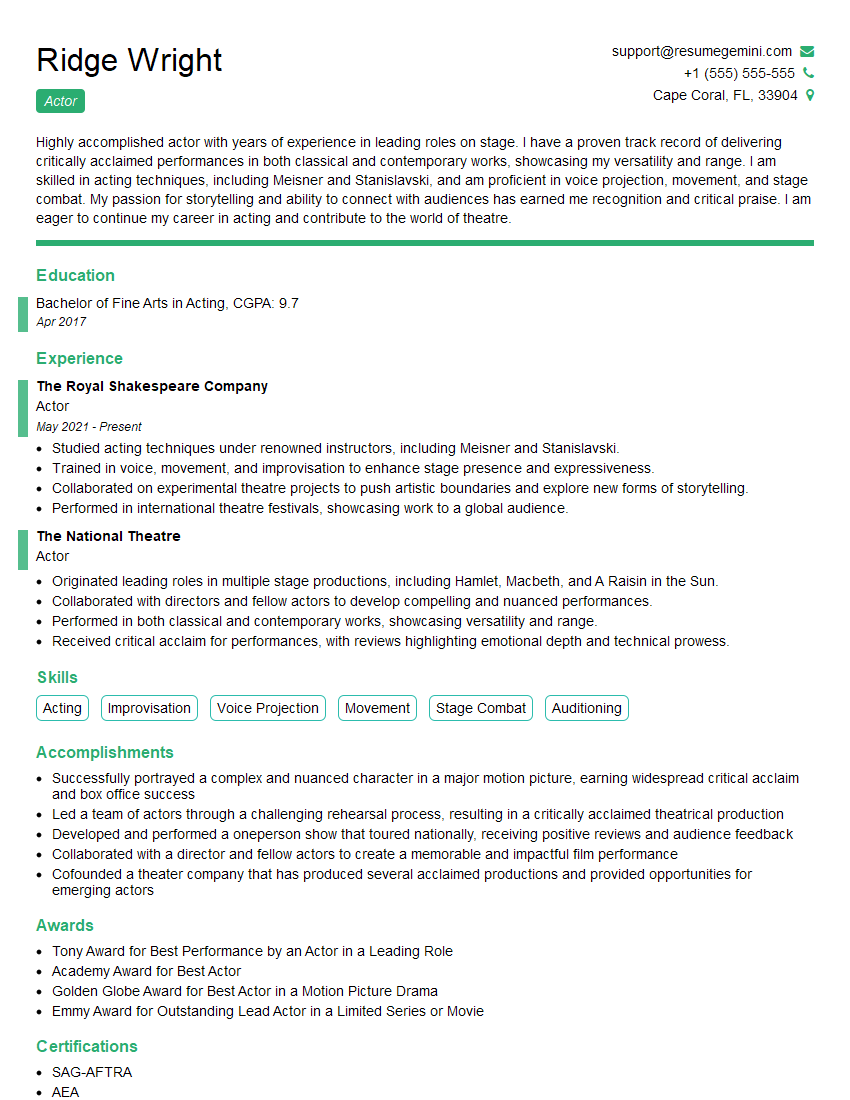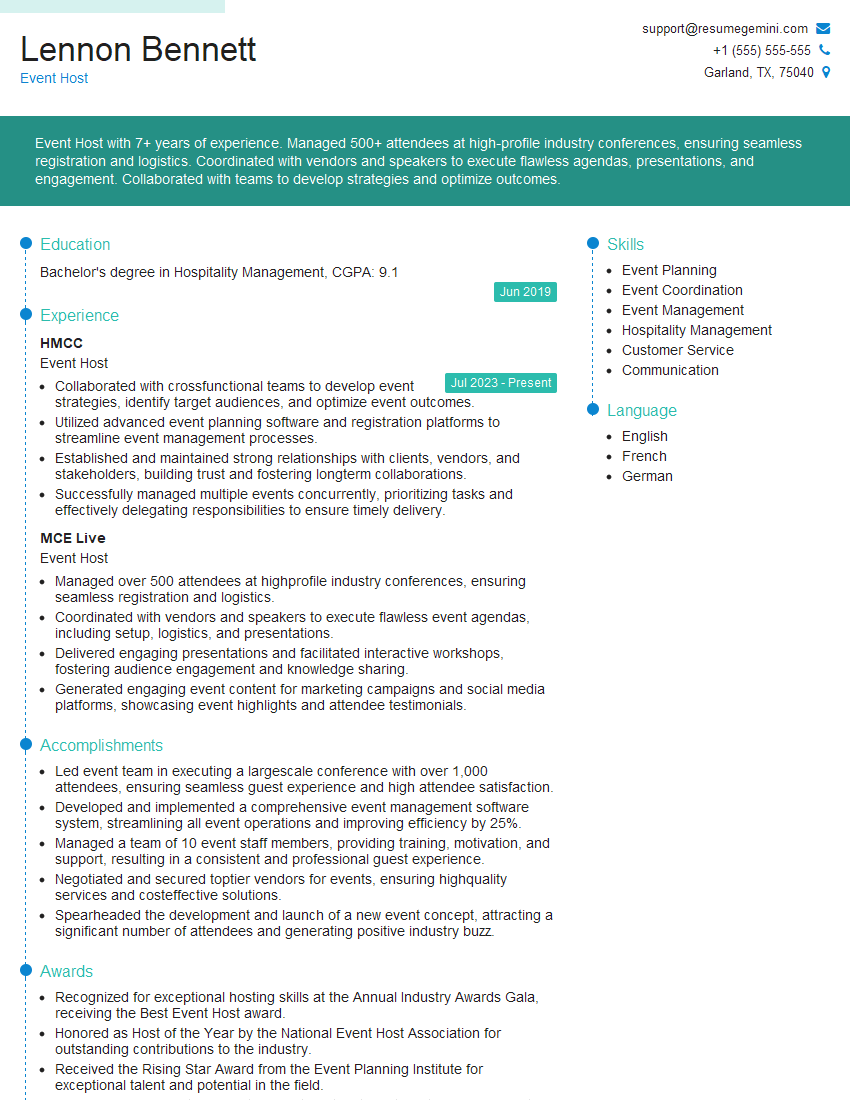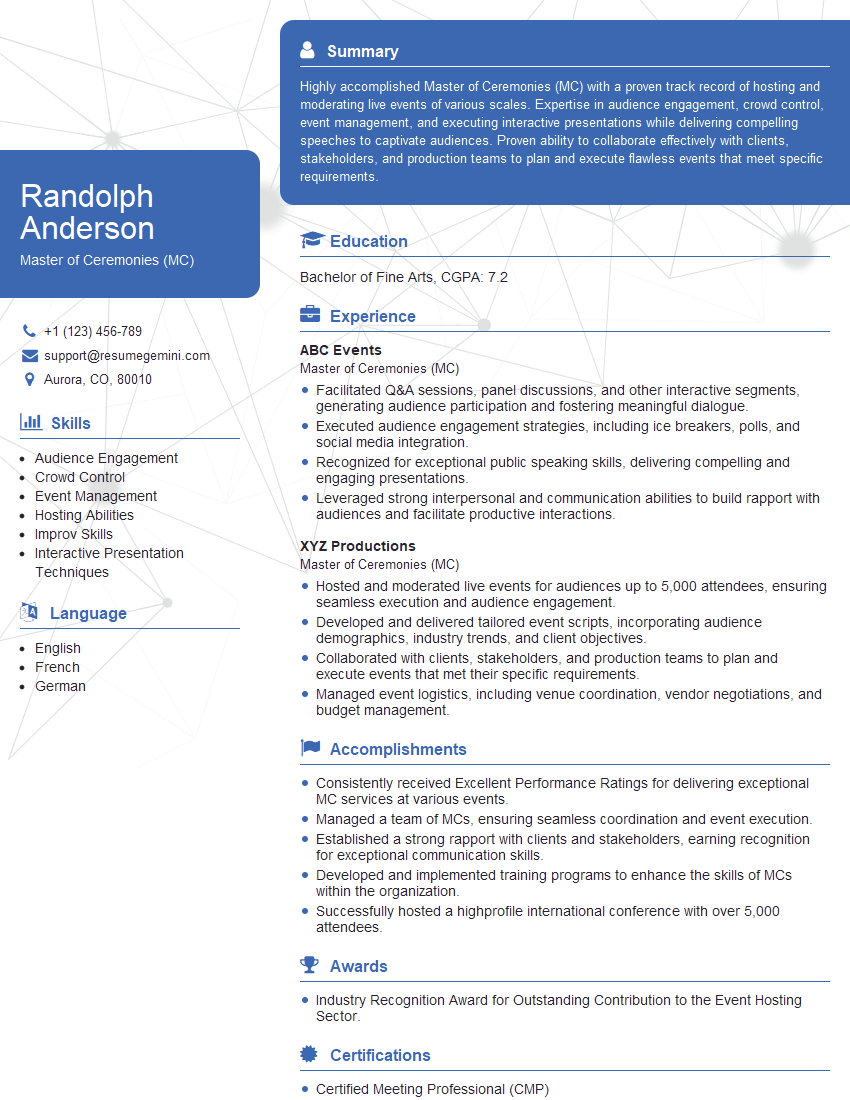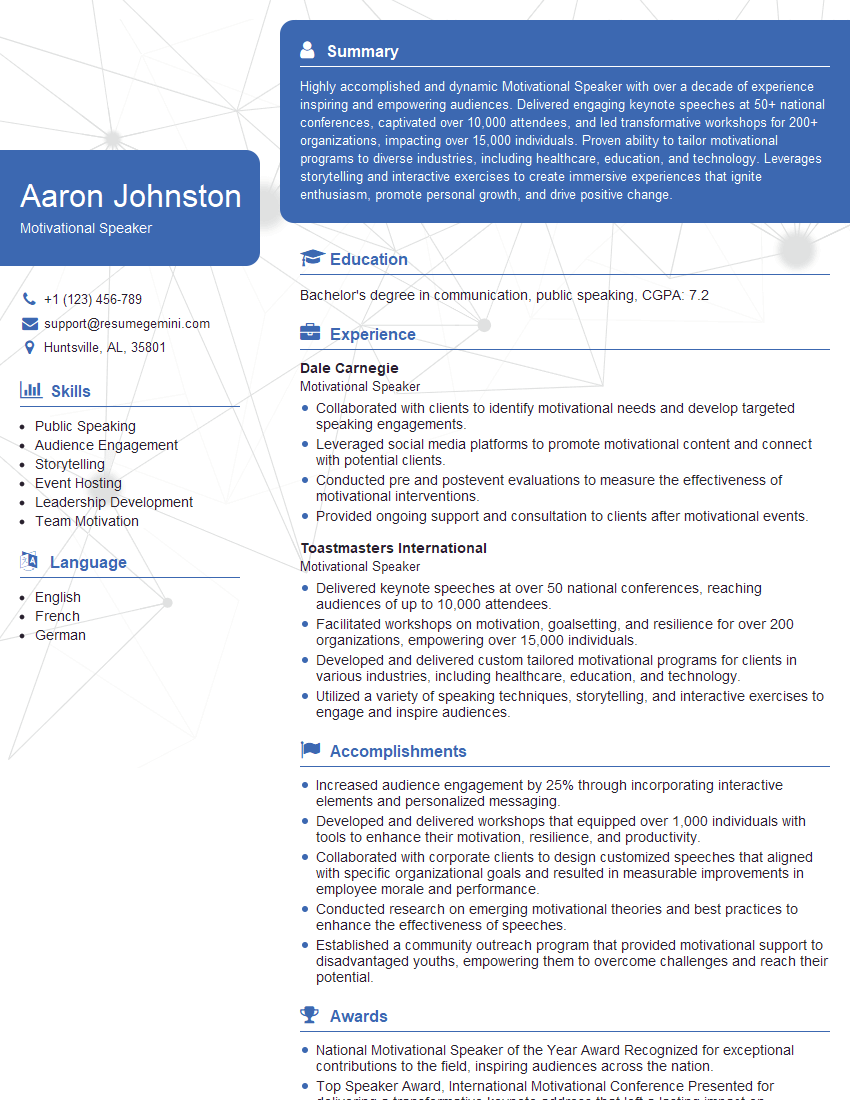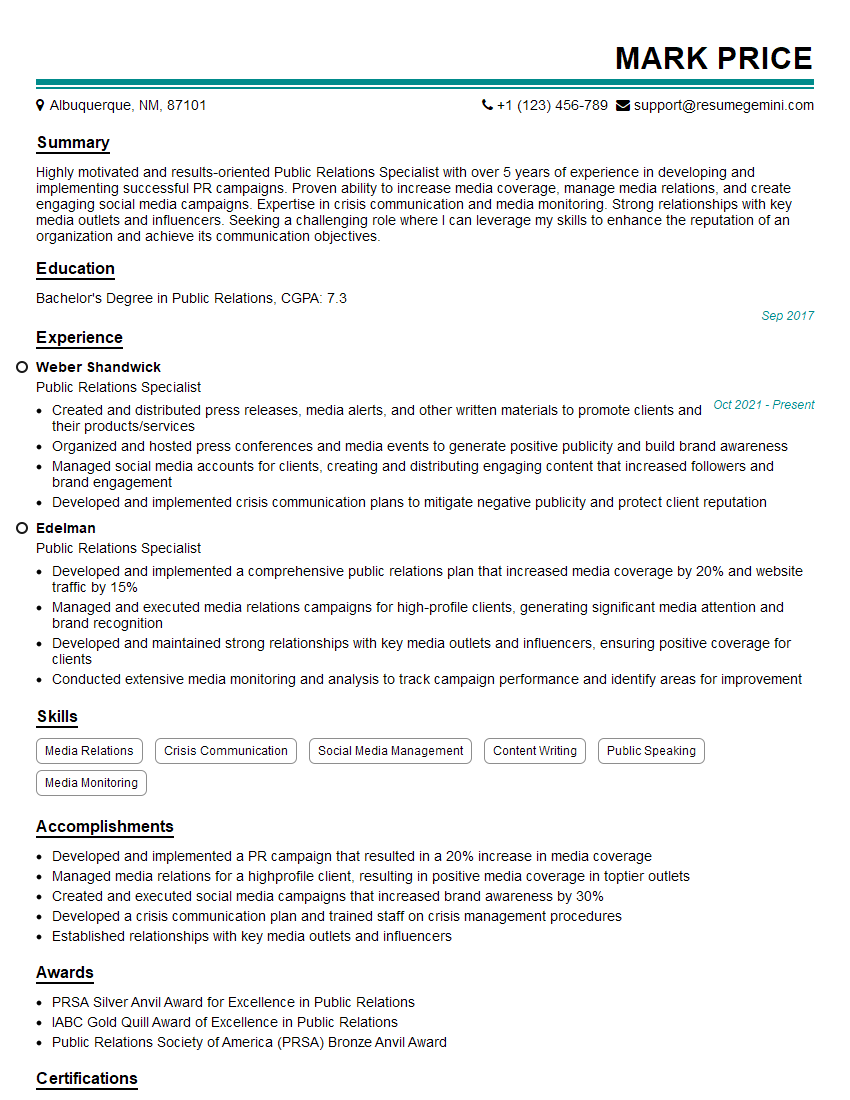Every successful interview starts with knowing what to expect. In this blog, we’ll take you through the top Stage Presence and Audience Engagement interview questions, breaking them down with expert tips to help you deliver impactful answers. Step into your next interview fully prepared and ready to succeed.
Questions Asked in Stage Presence and Audience Engagement Interview
Q 1. Describe your approach to managing stage fright.
Stage fright is a common experience, but it’s manageable. My approach is multifaceted, focusing on preparation, relaxation techniques, and reframing negative thoughts. Preparation is key; the more familiar I am with my material, the less anxious I feel. This includes thorough rehearsal, not just memorizing words, but also practicing transitions and anticipating potential questions. I utilize relaxation techniques like deep breathing exercises and mindfulness before presentations to calm my nerves. Finally, I reframe negative thoughts – instead of focusing on potential failure, I concentrate on the positive impact I can have on the audience.
For example, before a significant presentation, I’ll spend time visualizing a successful delivery, focusing on positive feedback and engagement. This mental rehearsal builds confidence and reduces anxiety. I also incorporate physical exercises like a short walk or some stretching to release tension.
Q 2. How do you adapt your presentation style to different audiences?
Adapting my presentation style to different audiences is crucial for effective communication. I consider several factors: audience size, their prior knowledge of the subject, their demographics, and the context of the presentation. A presentation to a large, formal conference will differ significantly from one given to a small, informal workshop.
- Large, formal audience: I’ll use a more structured approach with clear visual aids, a strong opening and closing, and a formal tone.
- Small, informal audience: I’ll use a more conversational style, encouraging interaction and allowing for more spontaneity.
- Technical audience: I’ll incorporate more technical details and jargon, ensuring clear explanations.
- Non-technical audience: I’ll simplify complex concepts, using analogies and avoiding jargon.
For instance, when presenting complex financial data to a group of investors, I’ll focus on clear visuals and concise explanations. However, if presenting the same information to a group of students, I’ll use more interactive elements, like polls or Q&A sessions, to maintain engagement and comprehension.
Q 3. Explain your method for captivating an audience from the outset.
Captivating an audience from the outset requires a strong opening that grabs their attention and establishes a connection. I use a variety of techniques to achieve this, including:
- A compelling story: A relatable anecdote or a surprising statistic can instantly engage the audience and create a memorable opening.
- A thought-provoking question: This encourages audience participation from the start, fostering engagement and curiosity.
- A powerful visual: A striking image or video can capture attention and set the tone for the presentation.
- A bold statement: A confident and assertive opening statement can create a sense of anticipation and excitement.
For example, I once started a presentation on workplace productivity by sharing a surprising statistic about lost productivity due to lack of focus. This immediately captured the audience’s attention and set the stage for my discussion on improving focus and efficiency.
Q 4. How do you maintain audience engagement during a long presentation?
Maintaining audience engagement throughout a long presentation requires careful planning and execution. I use several strategies to keep the audience involved and prevent their attention from waning. These include:
- Varying the pace and style of delivery: Incorporating humor, stories, and interactive elements prevents monotony.
- Using visual aids effectively: Well-designed slides, videos, or interactive demonstrations enhance engagement and understanding.
- Incorporating breaks and Q&A sessions: Regular breaks provide an opportunity for the audience to relax and process information, and Q&A sessions encourage active participation.
- Creating a sense of community: Encouraging audience interaction and creating a conversational atmosphere keeps everyone involved.
For instance, during a lengthy presentation on climate change, I’d incorporate short videos showcasing the impact of climate change, intersperse the technical information with personal stories from affected communities, and use interactive polls to gauge audience understanding and solicit their opinions.
Q 5. Describe a time you had to improvise during a presentation. What was your approach?
During a presentation on leadership styles, a crucial slide containing key data unexpectedly failed to load due to a technical glitch. Instead of panicking, I took a deep breath and improvised. I paraphrased the data points from memory, highlighting the main trends and focusing on the message rather than the specific numbers. I used the unexpected delay as an opportunity to connect with the audience, acknowledging the technical difficulty and making light of the situation with a brief, self-deprecating joke.
My approach was to remain calm, confident, and adaptable. I emphasized the core message of the slide and seamlessly transitioned to the next point. The audience responded positively, appreciating my composure and ability to handle the unexpected.
Q 6. How do you use nonverbal communication to enhance your message?
Nonverbal communication is just as important as verbal communication in enhancing a message. I utilize body language to amplify and support my words. This includes:
- Maintaining eye contact: Connecting with individual audience members creates a sense of personal connection and engagement.
- Using open and welcoming postures: Open body language conveys confidence and approachability.
- Using gestures purposefully: Gestures can emphasize key points and make the presentation more dynamic.
- Varying vocal tone and pace: A modulated voice keeps the audience engaged and prevents monotony.
For example, when discussing a particularly crucial point, I might pause for emphasis, make a deliberate gesture, and adjust my voice tone to highlight its significance. Maintaining a confident and approachable demeanor throughout the presentation creates a positive and engaging atmosphere for the audience.
Q 7. How do you handle Q&A sessions effectively?
Effective Q&A sessions require careful preparation and skillful moderation. My approach involves:
- Anticipating potential questions: I brainstorm likely questions and prepare concise, well-articulated answers.
- Managing time effectively: I allocate sufficient time for Q&A and ensure each question receives adequate attention.
- Restating questions for clarity: This ensures everyone understands the question and allows time to formulate a thoughtful response.
- Handling difficult questions diplomatically: I acknowledge challenging questions and address them openly and honestly, while maintaining professionalism.
- Summarizing key takeaways: At the end of the Q&A session, I briefly summarize the key points discussed and offer additional resources if necessary.
For example, if faced with a question I don’t fully know the answer to, I’ll acknowledge that I don’t have a definitive answer immediately, but I will follow-up with the information after further research. Honesty and transparency build trust and credibility.
Q 8. How do you incorporate visual aids to enhance audience understanding?
Visual aids are crucial for enhancing audience understanding. They shouldn’t just be decorative; they should directly support and clarify your message. Think of them as visual storytelling elements.
- Choosing the Right Visuals: The type of visual aid depends on your content. For complex data, a well-designed chart or graph is ideal. For illustrating a process, a flowchart or diagram works best. Images can evoke emotion and create a more memorable experience. Avoid cluttered or overly complicated visuals that distract from your message.
- Strategic Placement: Don’t just throw visuals up on the screen. Introduce them at the appropriate moment, explaining their relevance to your point. Allow ample time for the audience to process the information.
- Keep it Concise: Visuals should be succinct. Avoid overwhelming the audience with too much text or detail on a single slide. Use bullet points, clear headings, and visually appealing layouts.
- Example: In a presentation on climate change, I might use a compelling before-and-after image of a glacier to illustrate the impact of rising temperatures. I would then explain the data behind the image, reinforcing the visual with concrete figures.
Q 9. How do you use storytelling to connect with your audience?
Storytelling is a powerful tool for connecting with audiences because it taps into our innate human desire for narrative. People remember stories much better than data points.
- Structure your Story: A good story has a beginning, a middle (with rising tension), and an end (resolution). Clearly define your characters, setting, and conflict.
- Relatable Characters: Your story should feature characters the audience can connect with. These characters don’t need to be fictional; they can be real people representing various viewpoints.
- Emotional Connection: Stories evoke emotions, and emotional engagement creates a more lasting impression. Consider how you can incorporate elements of joy, sadness, surprise, or even fear to captivate your audience.
- Example: When discussing the importance of teamwork, I might share a personal anecdote about a collaborative project that initially faced challenges but ultimately succeeded due to the combined efforts of the team. This personal touch makes the message more relatable and memorable.
Q 10. What techniques do you use to gauge audience comprehension?
Gauging audience comprehension is an ongoing process, not a single event. You need to be observant and responsive throughout your presentation.
- Nonverbal Cues: Observe your audience’s body language. Are they engaged, confused, or bored? Are they making eye contact? Are they nodding in agreement or looking puzzled?
- Verbal Feedback: Pause frequently to allow for questions and comments. Encourage participation through open-ended questions.
- Polls and Quizzes: Incorporate quick polls or quizzes using technology to assess understanding at key points in your presentation.
- Post-Presentation Feedback: Collect feedback after your presentation through surveys or informal conversations to get a clearer picture of how your message was received.
- Example: If I see several people looking confused after explaining a complex concept, I’ll pause, ask if anyone has any questions, and re-explain the concept using simpler language or a different analogy.
Q 11. Describe your experience using technology to enhance your presentations.
Technology can significantly enhance presentations, but it’s crucial to use it strategically and effectively, not as a distraction.
- Presentation Software: Software like PowerPoint or Google Slides allows for incorporating visuals, animations, and interactive elements.
- Interactive Tools: Tools like Kahoot! or Mentimeter can be used for quizzes, polls, and Q&A sessions, increasing audience engagement.
- Video and Audio: Incorporating short videos or audio clips can add variety and enhance understanding.
- Live Streaming and Webinars: For larger audiences, live streaming or webinars provide access to a wider range of participants.
- Example: In a recent presentation on digital marketing, I used a short video demonstrating the use of a specific analytics tool. This made the explanation more concrete and engaging than simply explaining it verbally.
Q 12. How do you tailor your message to resonate with specific demographics?
Tailoring your message to resonate with specific demographics requires understanding their values, interests, and communication styles.
- Research Your Audience: Before your presentation, research the demographics of your audience and their knowledge level on the topic.
- Language and Tone: Adapt your language and tone to suit your audience. Avoid jargon or technical terms that may not be understood by everyone.
- Content Relevance: Focus on aspects of your message that are most relevant and interesting to your specific audience. Use examples and case studies that are relevant to their experiences.
- Visuals and Storytelling: Select visuals and storytelling approaches that are culturally appropriate and resonate with your audience’s background.
- Example: When presenting to a group of young professionals, I might use more informal language and relatable examples from popular culture, compared to a presentation for a group of senior executives who would appreciate a more formal and data-driven approach.
Q 13. How do you manage disruptive audience members?
Managing disruptive audience members requires tact, diplomacy, and a firm but respectful approach.
- Address the Disruption Directly but Gently: Acknowledge the disruption without making the audience member feel singled out or embarrassed.
- Empathy and Understanding: Try to understand the reason for the disruption. Are they bored? Confused? Do they have a legitimate question?
- Re-engage the Audience: Once the disruption is addressed, redirect attention back to the presentation and try to regain the audience’s focus.
- Seek Assistance if Necessary: In extreme cases, don’t hesitate to seek assistance from event organizers or security personnel.
- Example: If someone starts talking loudly during a quiet moment, I might say something like, “I appreciate your enthusiasm, but let’s keep the conversation to the Q&A session at the end.”
Q 14. How do you create a sense of connection with your audience?
Creating a sense of connection with the audience is fundamental to effective communication. It’s about building rapport and making the audience feel seen and heard.
- Eye Contact: Make eye contact with individuals throughout the audience, creating a sense of personal connection.
- Personal Anecdotes: Share relevant personal anecdotes to make the presentation more relatable and human.
- Use Inclusive Language: Use inclusive language that makes everyone feel welcome and respected.
- Active Listening: Actively listen to audience questions and comments, showing that you value their input.
- Body Language: Use open and welcoming body language, such as smiling, nodding, and maintaining good posture.
- Example: Starting a presentation with a personal story about how the topic relates to my own experiences helps create an immediate connection with the audience, making them feel more invested in the message.
Q 15. What are your strategies for incorporating humor appropriately into presentations?
Humor is a powerful tool for audience engagement, but it needs careful consideration. My strategy is threefold: Know your audience – what kind of humor resonates with them? A joke that works for a group of tech professionals might fall flat with a group of senior executives. Keep it relevant – the humor should relate to the topic at hand or the overall theme of the presentation, not be a random aside. And finally, less is more. A few well-placed, relevant jokes are far more effective than a constant stream of attempts at humor that might distract from your message. For instance, if I’m presenting on project management, I might use a self-deprecating anecdote about a past project mishap, relating it back to a key learning point. This grounds the humor in the subject matter and makes it memorable.
Career Expert Tips:
- Ace those interviews! Prepare effectively by reviewing the Top 50 Most Common Interview Questions on ResumeGemini.
- Navigate your job search with confidence! Explore a wide range of Career Tips on ResumeGemini. Learn about common challenges and recommendations to overcome them.
- Craft the perfect resume! Master the Art of Resume Writing with ResumeGemini’s guide. Showcase your unique qualifications and achievements effectively.
- Don’t miss out on holiday savings! Build your dream resume with ResumeGemini’s ATS optimized templates.
Q 16. How do you ensure your presentation is both informative and engaging?
Balancing informative content with audience engagement is crucial. I achieve this by using a variety of techniques. First, I structure my presentations with a clear narrative arc, moving from a compelling introduction to a satisfying conclusion. This keeps the audience invested. Second, I incorporate multimedia elements – images, videos, even short interactive polls – to break up the monotony of text-heavy slides. Think of it as storytelling with visual aids. Finally, I build in opportunities for interaction – asking questions, encouraging discussion, or using audience response systems. For example, during a presentation on data analysis, I might show a compelling visualization of data and then ask the audience to interpret its meaning, actively engaging them in the learning process.
Q 17. What metrics do you use to measure the effectiveness of your presentation?
Measuring presentation effectiveness goes beyond simply counting attendees. I use a multi-faceted approach. Post-presentation surveys gather feedback on clarity, engagement, and overall impact. Audience participation levels – the number of questions asked, the level of interaction during polls or discussions – are valuable indicators of engagement. Follow-up metrics, such as website traffic or sales leads generated after the presentation (if applicable), indicate the long-term impact of the message. Finally, observation and reflection – noting audience reactions during the presentation itself – provides crucial qualitative data.
Q 18. How do you handle criticism or negative feedback regarding a presentation?
Criticism, even negative feedback, is valuable. I approach it as an opportunity for growth. My first step is to carefully review the feedback, focusing on the constructive elements. What specific points were raised? Were there recurring themes? Next, I consider the source – is it from a trusted peer, a senior colleague, or someone with less relevant experience? This helps me weight the feedback appropriately. Finally, I identify areas for improvement. Did I miss a key point? Was my pacing too fast? I then incorporate these learnings into future presentations, continuously refining my approach. For example, if feedback highlights a lack of clarity on a specific technical point, I would revise that section to be more concise and understandable.
Q 19. Describe your experience with different presentation formats (e.g., webinars, in-person events).
I’ve presented in various formats, and each requires a tailored approach. In-person presentations allow for immediate audience feedback and stronger personal connection. I can adapt my delivery in real-time to the audience’s response. Webinars require more structured planning and often rely heavily on visual aids. I use interactive elements like Q&A sessions and polls to maintain engagement in a virtual environment. Hybrid events, combining in-person and online attendees, present unique challenges. I address both audiences equally, utilizing technology like live streaming and interactive tools to bridge the gap. The key difference lies in understanding the technical limitations and audience dynamics specific to each format and tailoring the presentation accordingly.
Q 20. How do you deal with unexpected technical difficulties during a presentation?
Technical difficulties are inevitable. My strategy is preparedness and adaptability. Before the presentation, I thoroughly test all equipment and software. I have backup plans – a printed copy of the slides, an alternative presentation method if the projector fails, etc. During the presentation, if a problem occurs, I acknowledge it calmly and address it directly. I might ask for a moment, or use the unexpected downtime as an opportunity for a brief, informal interaction with the audience, making it part of the narrative. Transparency and a sense of calm are key. The audience is generally understanding if you handle the unexpected professionally.
Q 21. How do you prepare for a presentation in a new or unfamiliar environment?
Presenting in a new environment requires proactive preparation. I visit the venue beforehand, if possible, to familiarize myself with the layout, the technology available, and the overall ambiance. I check the acoustics, lighting, and seating arrangements. This helps me adjust my delivery and presentation style accordingly. If a site visit isn’t possible, I’ll use online tools like Google Street View or venue websites to get a sense of the space. Knowing the environment in advance reduces stress and allows me to focus on the presentation itself rather than dealing with unexpected surprises.
Q 22. What strategies do you use to build rapport with an audience?
Building rapport with an audience is crucial for effective communication. It’s about creating a connection that fosters trust and encourages engagement. I achieve this through several key strategies:
- Starting with a relatable story or anecdote: This immediately connects me to the audience on a human level, making them feel seen and understood. For example, I might begin a presentation on effective teamwork by sharing a personal experience of overcoming a challenge with a team.
- Using inclusive language: Avoiding jargon and speaking in a clear, concise manner ensures everyone feels included and understood. I actively choose words that resonate with my audience’s background and knowledge.
- Making eye contact: I intentionally make eye contact with individuals throughout the audience, creating a sense of personal connection and showing that I value their presence. It avoids the feeling of talking *at* an audience rather than *with* them.
- Using humor appropriately: Well-placed humor can break the ice, create a more relaxed atmosphere, and make the presentation more memorable. However, I’m mindful of the context and audience to ensure the humor is relevant and inclusive.
- Showing genuine enthusiasm and passion: My genuine interest in the topic is contagious, and it helps create a positive and engaging atmosphere. Enthusiasm is infectious!
Q 23. Explain your understanding of the importance of active listening in audience engagement.
Active listening is paramount in audience engagement. It’s more than just hearing words; it’s about truly understanding the audience’s perspective, their needs, and their reactions to my presentation. This involves:
- Observing non-verbal cues: Paying close attention to body language – facial expressions, posture, and engagement levels – allows me to gauge how well the message is being received and adjust my delivery accordingly. A restless audience might indicate I need to pick up the pace or change my approach.
- Responding to questions and comments thoughtfully: I never dismiss or rush through questions. Each question is an opportunity to demonstrate understanding and further connect with the audience. I’ll often paraphrase a question to ensure I understand correctly before answering.
- Adapting the presentation based on feedback: If I notice a significant portion of the audience seems confused or disengaged by a particular section, I’ll adjust my delivery or provide further clarification. This shows responsiveness and demonstrates respect for the audience’s time and understanding.
- Creating space for dialogue: Incorporating opportunities for questions and discussion throughout the presentation, not just at the end, makes the audience feel heard and valued. It transforms a lecture into a conversation.
Q 24. How do you incorporate audience participation into your presentations?
Audience participation significantly boosts engagement and makes the learning experience more interactive and memorable. Here’s how I incorporate it:
- Polls and quizzes: Quick polls using interactive tools or simple show of hands can gauge understanding and encourage immediate feedback. This keeps the audience actively involved and allows for immediate adjustments if needed.
- Small group discussions: Breaking the audience into smaller groups for focused discussions on specific topics promotes collaboration and deeper understanding. This is particularly effective for complex or challenging material.
- Q&A sessions: Dedicated Q&A sessions, ideally throughout the presentation, create opportunities for clarification and deeper engagement. I aim to create a safe space for questions, even those that might challenge my ideas.
- Interactive games or activities: Depending on the context and audience, incorporating relevant games or activities can add a playful element, fostering camaraderie and active participation.
- Open-ended questions: Posing thought-provoking questions to the audience and giving them time to reflect before responding encourages deeper engagement and sparks meaningful conversation.
Q 25. Describe a successful presentation you gave. What made it successful?
One particularly successful presentation I delivered was on the topic of innovative leadership for a group of mid-level managers. What made it successful was a combination of factors:
- Relevance: The content was directly relevant to their daily challenges and aspirations, addressing their specific needs and pain points. I tailored examples and case studies to their industry.
- Interactive elements: I incorporated several interactive exercises and group discussions, encouraging active participation and peer-to-peer learning. This resulted in lively discussions and greater knowledge retention.
- Strong visual aids: I used compelling visuals, including short videos and interactive charts, to reinforce key concepts and maintain audience engagement. The visuals were not just decorative; they added value to the content.
- Authenticity: I shared personal anecdotes and experiences, making the presentation relatable and demonstrating my own expertise. Vulnerability built trust.
- Positive feedback: I received overwhelmingly positive feedback, with many attendees stating that the presentation was insightful, engaging, and actionable. The post-presentation survey confirmed high levels of satisfaction and knowledge gained.
Q 26. What is your process for rehearsing and refining a presentation?
My rehearsal process is rigorous and iterative. It’s not simply about memorizing the script; it’s about refining the delivery and ensuring a seamless flow. Here’s my approach:
- Initial outline and script development: I begin with a detailed outline, then develop a script, focusing on clear, concise language and a logical flow of ideas.
- First rehearsal with self-recording: I rehearse the entire presentation while recording myself. This allows me to objectively assess my delivery, identify areas for improvement in pacing, clarity, and enthusiasm.
- Refining the script and delivery: Based on the self-recording, I refine the script, addressing any unclear sections or areas where my delivery felt weak. I may rewrite sections, add visual aids, or rearrange the order of points.
- Rehearsal with a test audience: I rehearse with a small, trusted group who provide feedback on clarity, engagement, and pacing. Their input is invaluable in identifying areas needing further refinement.
- Final polish and timing: The final rehearsal focuses on fine-tuning the delivery, ensuring the presentation fits within the allocated time, and optimizing the visual aids.
Q 27. How do you ensure your presentation is inclusive and accessible to all audience members?
Inclusivity and accessibility are paramount. My approach involves:
- Diverse examples and case studies: I use examples and case studies that represent a wide range of backgrounds and experiences, avoiding biases and stereotypes.
- Accessible language and visual aids: I use clear, concise language, avoiding jargon and complex terminology. Visual aids are designed with accessibility in mind, including alt-text for images and clear font choices.
- Considering different learning styles: I incorporate various presentation methods – storytelling, visuals, interactive elements – to cater to diverse learning preferences.
- Providing alternative formats: Where appropriate, I provide alternative formats of the presentation materials, such as transcripts or audio recordings, to cater to individuals with disabilities.
- Creating a safe and respectful environment: I foster a welcoming and inclusive atmosphere where everyone feels comfortable participating and asking questions. This is crucial for ensuring all voices are heard.
Q 28. How do you maintain your energy and enthusiasm throughout a long presentation?
Maintaining energy and enthusiasm throughout a long presentation requires careful planning and self-care. My strategies include:
- Strategic breaks: Incorporating short breaks throughout the presentation allows for a moment to regroup and refocus. These breaks also provide opportunities for audience interaction and engagement, which helps re-energize both the presenter and the audience.
- Hydration and healthy snacks: Staying well-hydrated and having healthy snacks readily available helps maintain physical energy levels.
- Varying the pace and delivery: Switching between different presentation styles—stories, statistics, visuals, interaction—helps maintain audience interest and prevents monotony. This keeps *me* engaged, too.
- Movement and gestures: Using purposeful movement and gestures keeps the presentation dynamic and prevents stiffness. It also helps burn some energy.
- Passion and connection with the material: My genuine passion for the subject is a powerful source of energy. Connecting with the audience on an emotional level fuels the presentation.
Key Topics to Learn for Stage Presence and Audience Engagement Interview
- Understanding Your Audience: Analyzing audience demographics, expectations, and potential engagement levels to tailor your presentation style.
- Nonverbal Communication: Mastering body language, including posture, eye contact, gestures, and facial expressions, to convey confidence and connect with the audience.
- Vocal Delivery: Developing clear articulation, pacing, and modulation of your voice to maintain audience interest and understanding.
- Engaging Storytelling: Crafting narratives and using relevant examples to illustrate key points and create a memorable experience.
- Handling Q&A Sessions: Preparing for questions, anticipating potential challenges, and responding confidently and professionally.
- Managing Nervousness: Implementing techniques for controlling anxiety and projecting calm confidence even under pressure.
- Using Visual Aids Effectively: Choosing appropriate visuals and using them strategically to enhance the message and maintain audience engagement.
- Adapting to Different Settings: Adjusting your approach to accommodate various venues, technologies, and audience sizes.
- Creating a Powerful Opening and Closing: Developing strong hooks to capture attention and memorable conclusions to leave a lasting impression.
- Practicing and Refining Your Delivery: Utilizing rehearsal strategies to build fluency, confidence, and responsiveness.
Next Steps
Mastering stage presence and audience engagement is crucial for career advancement across numerous fields. Strong communication skills are highly valued, opening doors to leadership roles and increasing your impact. To maximize your job prospects, crafting an ATS-friendly resume that highlights these skills is essential. ResumeGemini is a trusted resource to help you build a professional and impactful resume that showcases your abilities effectively. Below you’ll find examples of resumes tailored to highlight Stage Presence and Audience Engagement skills. Investing time in refining your resume will significantly improve your chances of securing your dream job.
Explore more articles
Users Rating of Our Blogs
Share Your Experience
We value your feedback! Please rate our content and share your thoughts (optional).
What Readers Say About Our Blog
Hello,
We found issues with your domain’s email setup that may be sending your messages to spam or blocking them completely. InboxShield Mini shows you how to fix it in minutes — no tech skills required.
Scan your domain now for details: https://inboxshield-mini.com/
— Adam @ InboxShield Mini
Reply STOP to unsubscribe
Hi, are you owner of interviewgemini.com? What if I told you I could help you find extra time in your schedule, reconnect with leads you didn’t even realize you missed, and bring in more “I want to work with you” conversations, without increasing your ad spend or hiring a full-time employee?
All with a flexible, budget-friendly service that could easily pay for itself. Sounds good?
Would it be nice to jump on a quick 10-minute call so I can show you exactly how we make this work?
Best,
Hapei
Marketing Director
Hey, I know you’re the owner of interviewgemini.com. I’ll be quick.
Fundraising for your business is tough and time-consuming. We make it easier by guaranteeing two private investor meetings each month, for six months. No demos, no pitch events – just direct introductions to active investors matched to your startup.
If youR17;re raising, this could help you build real momentum. Want me to send more info?
Hi, I represent an SEO company that specialises in getting you AI citations and higher rankings on Google. I’d like to offer you a 100% free SEO audit for your website. Would you be interested?
Hi, I represent an SEO company that specialises in getting you AI citations and higher rankings on Google. I’d like to offer you a 100% free SEO audit for your website. Would you be interested?
good




